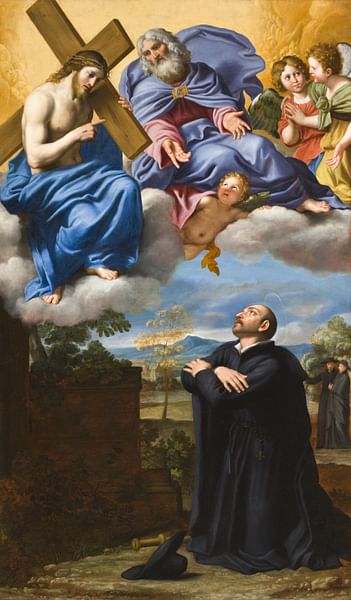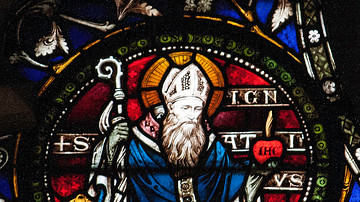The Spiritual Exercises of Ignatius Loyola (1548) is a manual of disciplines formulated by Ignatius Loyola (l. 1491-1556) to prepare one spiritually for Christian service. They were initially developed between 1522-1524 by Loyola for himself and then shared with others, specifically his friends who formed the Society of Jesus (Jesuits) in 1534. It was first published in 1548.

Loyola was a Basque soldier in service to Spain when he was wounded at the Battle of Pamplona in 1521. While recovering, he read books on the life of Jesus Christ and the saints and devoted himself to Christ. He developed his exercises in a cave near Manresa to discipline himself for spiritual service, just as he had earlier submitted to military training for the army. After traveling for a few years, he enrolled at the University of Paris in 1534, where he met the men with whom he would found the Jesuit Order and, at this time, introduced them to the exercises.
After Loyola's manual was approved by the pope and published in 1548, it became the instruction manual for those wishing to join the Jesuits and, in time, a classic spiritual work used by priests or religious authority figures in guiding others. In the present day, it remains a bestseller and is often used in workshops, religious retreats, and for spiritual and psychological self-improvement.
Background, Form, & Purpose of the Exercises
Prior to his injury at Pamplona, Loyola had been a courtier and ladies' man who was periodically in trouble with the law for various crimes but never punished because of his social standing. While convalescing and reading about the life of Christ and the acts of the saints, he felt deep remorse over his former life and, after he had recovered and devoted himself to Christian service, felt the need to do penance.
He traveled to Montserrat, where he confessed his sins to a priest for three days, renounced his former life, and, dressed in sackcloth, walked to Manresa. He spent his time there in service to others and in self-flagellation, prayer, and fasting to atone for his sins. In the cave near Manresa, he developed the discipline that would become the Spiritual Exercises as a means of ridding himself of attachment to the things of this world and opening himself up to the spirit of God. It is unclear what form the early exercises took, but by 1534, they were a four-week course during which one would progress from recognition of one's sin and unworthiness to acceptance of God's mercy and forgiveness and, by following Christ's path, to the realization of God's love and salvation through acceptance of Christ's gift of salvation.
According to the Autobiography of Saint Ignatius of Loyola, when he first introduced his friends to the exercises, they were not all eager to submit to the discipline as the goal was to leave one's former life behind to become 'a new creature in Christ'. This was not considered easy as one had to renounce former pleasures and interests, but, Loyola promised, the spiritual rewards far outweighed whatever an adherent abandoned during the four-week course, which consisted of:
- Week 1: Recognition of the self as sinful and confession of sin/Recognition of God's mercy
- Week 2: Emulating Christ's selflessness and commitment to others
- Week 3: Recognition of Christ's passion and sacrifice for the sins of the world
- Week 4: Acceptance of God's forgiveness through Christ's resurrection
By the end of the 4th week, one was expected to have become transformed. In keeping with the biblical admonition to "take captive every thought and to make it obedient to Christ" (II Corinthians 10:5), Loyola appended his Rules for Thinking with the Church to his Spiritual Exercises and equated "taking every thought captive to Christ" with "taking every thought captive to the Church." Loyola saw himself as a soldier for Christ who was committed not only to converting others but also to defending the Church against its enemies and detractors.

Rules for Thinking with the Church is probably the best-known section of the Spiritual Exercises as it is a direct refutation of the principles and practices of the anti-Catholic sects that had formed through the Protestant Reformation (1517-1648). The Catholic Counter-Reformation (1545 to c.1700), a response to the Protestant Reformation, had begun in 1545 with The Council of Trent, and Loyola's Jesuits would play a central role in reclaiming the authority and centrality of the Catholic Church. Rules for Thinking with the Church became an integral aspect of this effort as it encouraged unwavering devotion to Catholicism, and rejection of Protestant criticism, by stipulating how one should control one's thoughts and direct them always toward acceptance of and praise for the teachings of the Church.
Text
The following text is an excerpt from Rules for Thinking with the Church as given in A Reformation Reader: Primary Texts with Introductions edited by Denis R. Janz, pp. 428-429, drawn from The Spiritual Exercises of St. Ignatius Loyola, edited by L. J. Puhl, 1951.
The following rules should be observed to foster the true attitude of mind we ought to have in the church militant:
1. We must put aside all judgment of our own and keep the mind ever ready and prompt to obey in all things the true spouse of Christ our Lord, our holy mother, the hierarchical church.
2. We should praise sacramental confession, the yearly reception of the most blessed Sacrament, and praise more highly monthly reception, and still more weekly Communion, provided requisite and proper dispositions are present.
3. We ought to praise the frequent hearing of mass, the singing of hymns, psalmody, and long prayers whether in the church or outside; likewise, the hours arranged at fixed times for the whole Divine Office, for every kind of prayer, and for the canonical hours.
4. We must praise highly religious life, virginity, and continence; and matrimony ought not be praised as much as any of these.
5. We should praise vows of religion, obedience, poverty, chastity, and vows to perform other works of supererogation conducive to perfection. However, it must be remembered that a vow deals with matters that lead us closer to evangelical perfection. Hence, whatever tends to withdraw one from perfection may not be made the object of a vow, for example, a business career, the married state, and so forth.
6. We should show our esteem for the relics of the saints by venerating them and praying to the saints. We should praise visits to the station churches, pilgrimages, indulgences, jubilees, crusade indults, and the lighting of candles in churches.
7. We must praise the regulations of the church with regard to fast and abstinence, for example, in Lent, on ember days, vigils, Friday, and Saturdays. We should praise works of penance, not only those that are interior but also those that are exterior.
8. We ought to praise not only the building and adornment of churches, but also images and veneration of them according to the subject they represent.
9. Finally, we must praise all the commandments of the church, and be on the alert to find reasons to defend them, and by no means in order to criticize them.
10. We should be more ready to approve and praise the orders, recommendations, and way of acting of our superiors than to find fault with them. Though some of the orders, etc., may not have been praiseworthy, yet to speak against them, either when preaching in public or in speaking before the people, would rather be the cause of murmuring and scandal than of profit. As a consequence, the people would become angry with their superiors, whether secular or spiritual. But while it does harm in the absence of our superiors to speak evil of them before the people, it may be profitable to discuss their bad conduct with those who can apply a remedy.
11. We should praise both positive theology and that of the Scholastics. It is characteristic of the positive doctors, such as St. Augustine, St. Jerome, St. Gregory, and others, to rouse the affections so that we are moved to love and serve God our Lord in all things. On the other hand, it is more characteristic of the Scholastic doctors, such as St. Thomas, St. Bonaventure, the Master of the Sentences [Peter Lombard], and others, to define and state clearly, according to the needs of our times, the doctrines that are necessary for eternal salvation, and that more efficaciously help to refute all errors and expose all fallacies. Further, just because Scholastic doctors belong to more recent times, they not only have the advantage of correct understanding of Holy Scripture and of the teaching of the saints and positive doctors, but, enlightened by the grace of God, they also make use of the decisions of the councils and of the definitions and decrees of our holy mother church.
12. We must be on our guard against making comparisons between those who are still living and the saints who have gone before us, for no small error is committed if we say: "This man is wiser than St. Augustine" "He is another St. Francis or even greater," "He is equal to St. Paul in goodness and sanctity," and so on.
13. If we wish to proceed securely in all things, we must hold fast to the following principle: What seems to me white, I will believe black if the hierarchical church so defines. For I must be convinced that in Christ our Lord, the bridegroom, and in his spouse the church, only one Spirit holds sway, which governs and rules for the salvation of souls. For it is by the same Spirit and Lord who gave the Ten Commandments that our holy mother church is ruled and governed.
14. Granted that it be very true that no one can be saved without being predestined and without having faith and grace, still we must be very cautious about the way in which we speak of all these things and discuss them with others.
15. We should not make it a habit of speaking much of predestination. If somehow at times it comes to be spoken of, it must be done in such a way that the people are not led into any error. They are at times misled, so that they say: "Whether I shall be saved or lost, has already been determined, and this cannot be changed whether my actions are good or bad." So they become indolent and neglect the works that are conducive to the salvation and spiritual progress of their souls.
16. In the same way, much caution is necessary, lest by much talk about faith, and much insistence on it without any distinctions or explanations, occasion be given to the people, whether before or after they have faith informed by charity, to become slothful and lazy in good works.
17. Likewise, we ought not to speak of grace at such length and with such emphasis that the poison of doing away with liberty is engendered. Hence, as far as is possible with the help of God, one may speak of faith and grace that the divine majesty may be praised. But let it not be done in such a way, above all not in times which are as dangerous as ours, that works and free will suffer harm, or that they are considered of no value.
18. Though the zealous service of God our Lord out of pure love should be esteemed above all, we ought also to praise highly the fear of divine majesty. For not only filial fear but also servile fear is pious and very holy. When nothing higher or more useful is attained, it is very helpful for rising from mortal sin, and once this is accomplished, one may easily advance in filial fear, which is wholly pleasing and agreeable to God our Lord since it is inseparably associated with the love of him.
Conclusion
The Council of Trent (1545-1563) encouraged acceptance of the above 18 points by devout Catholics to prevent the spread of the Protestant vision of Christianity, which it denounced as heresy. The Protestant Reformation had begun with the objection by the theologian and monk Martin Luther (l. 1483-1546) to the Church's policy of selling indulgences. Once Luther's criticisms were accepted and won supporters, the authority of the Church was undermined, and so it was understood that to prevent this from recurring, the teachings of the Church should not be questioned.
Loyola's manual became an important part of the Church's response to Protestantism, not only for the month-long program of spiritual self-improvement but also for the Rules for Thinking with the Church, which applied to every Catholic. After The Council of Trent was underway and had rendered its early decisions on Protestantism, and after the publication of Spiritual Exercises, to call oneself 'Catholic' meant rejecting the claims of Protestant clergy and adhering closely to – as well as defending – the teachings of the Church, even if, in Loyola's words, "what seems to me white, I will believe black" if the Church teaches white as black.
Loyola's Spiritual Exercises were initially used for instruction of candidates for the order but, in time, became a teaching tool for Catholics who wanted to submit to the discipline for a closer relationship with God. By following Loyola's four-week course, it was understood one could experience significant spiritual transformation. In the modern era, the manual has also come to be used by Protestant denominations as a guide in religious retreats or for personal reflection and spiritual work while continuing to be understood as a classic of Catholic Counter-Reformation literature and spiritual literature in general.






